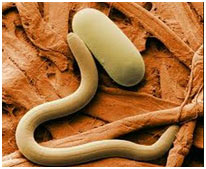The world of Nematoda, rooted in Latin, signifies “pointed ends,” a term befitting the distinctive morphology of these organisms.
As members of the phylum Aschelminthes, these creatures are collectively known as roundworms, characterized by their elongated bodies terminating in pointed ends.
General Characteristics of Phylum Aschelminthes
- Grade of organization: They are multicellular organisms and are triploblastic and pseudocoelomates.
- Shape and Symmetry: The nematodes display bilateral symmetry and the body is unsegmented. The nematodes vary from microscopic kinds to some form reaching a length of up to one metre.
- Habitat: The habitats of phylum Nematoda ranges from terrestrial to marine environments. Nematodes exist as free-living organisms in terrestrial and aquatic environments or as parasites of both plants and animals.
- Body Cavity: The body cavity is pseudocoelom. It is derived from the hollow area, the blastocoel, situated in the blastula, an early stage in embryological development, and not from the mesoderm. It consists of a number of vacuolated cells filled with a protein-rich fluid which establishes high hydrostatic pressure.
- Digestive system: The gastrointestinal system is in the kind of alimentary canal with two openings. The opening at the anterior end is mouth and at the posterior end is the anus. In parasitic nematodes, the digestive system is very simple and basic. A fluid-filled area exists between the body wall and the alimentary canal. It offers “tube within tube” type structure in nematodes.
- Organs and Organ systems: The circulatory and breathing systems are absent.
- Gaseous Exchange: The gaseous exchange occurs through the general body surface area.
- Sense organs: The sense organs are present in the type of sensory papillae present on the lips at the anterior end.
- Excretory System: The excretory system includes two longitudinally running excretory canals which unite at the anterior end to form a single canal that opens to the outside through an excretory pore on the ventral surface.
- Nervous system: There is a nerve ring around the pharynx in roundworms, which give rise to dorsal, ventral and lateral nerve cords running throughout the length of the worms.
- Movement: Locomotion is in whirl form undulating waves of contraction and relaxation of muscles. These muscles are set up in four bands, two dorso-lateral and two ventrolateral. The circular muscles are absent; therefore, the flexing is dorso-ventral just.
- Mode of nutrition: Their mode of nutrition is parasitic. They live in the host body and consume the food taken by the host. In some cases, roundworms are deadly as they consume all the food taken by the host consequently decreasing the health of the host and eventually death.
Reproduction in Phylum Aschelminthes
Sexual reproduction:
The sexes are separate. The female gonads are ovaries and these produce eggs. These male gonads are testes that produce sperm.
Life cycle
A larval phase is present in the life cycle.
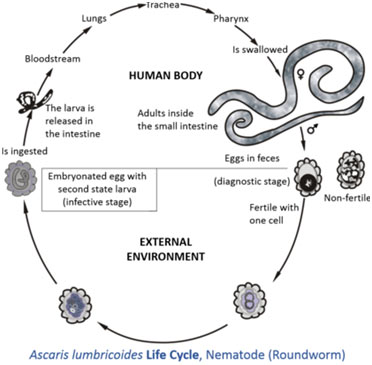
Parasitic life of Aschelminthes (Phylum Nematoda)
Aschelminthes is important from the perspective of its parasitic nature of which it has a fantastic variety of some very serious diseases in man and plants.
Ascaris lumbricoides is an intestinal tract parasite of man.
The genus Rhabditis contains various species normally found in soil, organic matter or water, and faeces of man or animals.
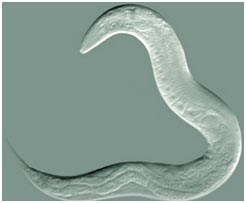
Enterobius vermicularis commonly called pinworm is cosmopolitan however more common in Europe and America. Pinworms are parasites in the human caecum, colon and appendix. Their movement triggers extreme itching of anus, swelling of the mucous membrane of colon and appendix resulting in insomnia and anorexia nervosa.
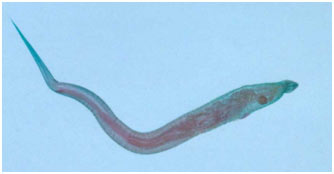
Ancylostoma duodenale is commonly called hookworm. It is a parasite of the human small intestine in Asia, North Africa and Europe. It is really hazardous due to the fact that it holds the villi of the intestine and draws blood and body fluid.
Throughout feeding they produce an anticoagulant to prevent clotting of blood and after feeding leave the injury bleeding. In kids, it can cause severe anaemia and slow down physical and psychological development.
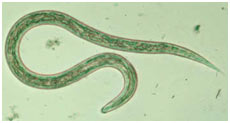
Frequently Asked Questions (FAQs) – Aschelminthes (Phylum Nematoda) – The Roundworms
1. What is the origin of the term “Nematoda,” and what does it signify?
- Answer: The term “Nematoda” originates from Latin, meaning “pointed ends,” reflecting the characteristic shape of these organisms.
2. How are roundworms classified within the animal kingdom, and what are their general characteristics?
- Answer: Roundworms belong to the phylum Aschelminthes. They are multicellular, triploblastic, and pseudocoelomates with an elongated body and pointed ends. The body displays bilateral symmetry and is unsegmented.
3. What is the habitat range of phylum Nematoda, and how do they exist in different environments?
- Answer: Nematodes inhabit a wide range of environments, from terrestrial to marine. They can exist as free-living organisms in various environments or as parasites in plants and animals.
4. What is the body cavity type in roundworms, and how is it formed?
- Answer: The body cavity in roundworms is a pseudocoelom, derived from the blastocoel in embryological development. It consists of vacuolated cells filled with a protein-rich fluid, creating high hydrostatic pressure.
5. How does the digestive system of nematodes function, especially in parasitic forms?
- Answer: Nematodes have an alimentary canal with a mouth at the anterior end and an anus at the posterior end. The digestive system is relatively simple in parasitic nematodes, featuring a “tube within tube” structure.
6. Describe the locomotion mechanism of roundworms.
- Answer: Roundworms move through whirl-form undulating waves of muscle contraction and relaxation. Muscles are arranged in four bands (two dorso-lateral and two ventrolateral), with dorso-ventral flexing.
7. What is the mode of nutrition for roundworms, and why are some considered deadly?
- Answer: Roundworms are parasitic, living in a host’s body and consuming the host’s food. Some roundworms can be deadly as they consume all the host’s food, leading to a decline in the host’s health and eventual death.
8. Explain the reproductive system and life cycle of Aschelminthes.
- Answer: Aschelminthes exhibit sexual reproduction with separate sexes. Females have ovaries producing eggs, while males have testes producing sperm. A larval phase is present in their life cycle.
9. Which diseases are associated with parasitic Aschelminthes, and what are their effects on humans?
- Answer: Aschelminthes, particularly nematodes, cause diseases such as Ascariasis (Ascaris lumbricoides), Pinworm infection (Enterobius vermicularis), and Hookworm infection (Ancylostoma duodenale). These parasites can lead to symptoms ranging from itching and inflammation to severe anemia in children.
Wrap Up: Aschelminthes (Phylum Nematoda) – The Roundworms
In conclusion, the exploration of Aschelminthes, or the phylum Nematoda, unveils a fascinating world of pointed-end organisms with diverse characteristics. These elongated, unsegmented creatures exhibit bilateral symmetry and inhabit a broad range of environments, from terrestrial to marine. Noteworthy is their pseudocoelom, derived from early embryological development, and their unique alimentary canal, featuring a “tube within tube” structure in parasitic forms.
These organisms operate without circulatory and respiratory systems, relying on gaseous exchange through the body surface. Sensory papillae on their lips serve as rudimentary sense organs. The nerve system, in the form of a ring around the pharynx, gives rise to dorsal, ventral, and lateral nerve cords, facilitating the undulating whirl-form locomotion.
The parasitic life of Aschelminthes holds significant implications, with examples like Ascaris lumbricoides causing intestinal tract issues in humans. The genus Rhabditis, Enterobius vermicularis (pinworm), and Ancylostoma duodenale (hookworm) underscore the variety of serious diseases affecting both humans and plants. The parasites’ mode of nutrition, primarily parasitic, can lead to severe consequences for the host, emphasizing the importance of understanding and managing these organisms.
Further reading on topics like biotechnology products and water absorption in plants provides additional context, highlighting the broader biological landscape. In essence, the world of Aschelminthes is one of complexity, adaptability, and, at times, profound impact on the ecosystems they inhabit.

